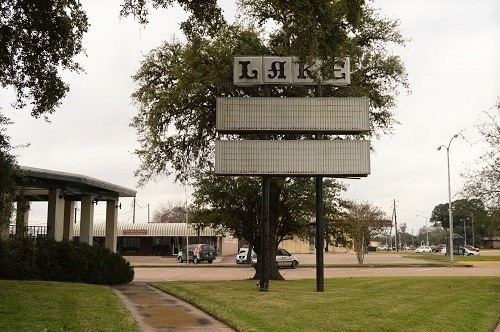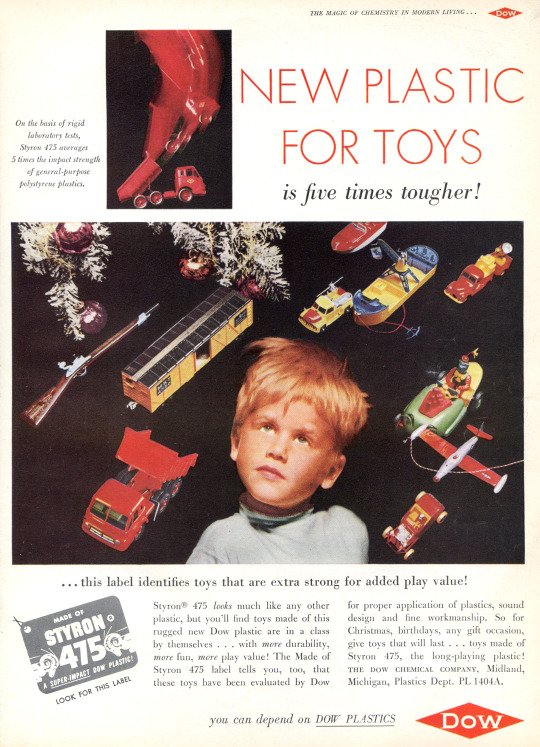#Dow Chemical
Text

"New strength for future fabrics." Dow Chemical print ad. ca. 1943.
Science History Institute
446 notes
·
View notes
Text
98 notes
·
View notes
Text

The chemistry of abundance.
#christmas#christmas season#holiday season#xmas#christmas holidays#vintage advertising#christmas advertising#christmas ads#americana#christmas aesthetic#vintage illustration#dow#dow chemical company#dow chemical#chemicals#chemistry
16 notes
·
View notes
Text

New way to kill the environment . . . plastics
The Saturday Evening Post - December 7th 1946
#1946#future#plastids#dow chemical#vintage ad#advertising#advertisement#Christmas gifts#Christmas ad#Vintage Christmas#Christmas#Xmas ad#xmas#1940s#1940s ad#1940's#1940's ad#funny#humor#humour
9 notes
·
View notes
Text

Print advertisement for Dow Chemical Company depicts a holiday scene with a Christmas tree rising from a bustling town square. People surround the tree, as if attending a tree-lighting ceremony. The paragraph below the image describes the meaning behind the title "The Chemistry of Abundance," specifically the jobs and conveniences brought about by the Dow Chemical Company's production of more than three hundred products.
image citation: Dow Chemical Company. “The Chemistry of Abundance,” 1939. Advertisements from the Dow Chemical Historical Collection, Box 7. Science History Institute. Philadelphia.
#chemistry#christmas#christmas tree#advertising#chemical industry#dow chemical company#dow chemical#happy holidays#holiday season#othmeralia
16 notes
·
View notes
Text
By Brett Wilkins
Common Dreams
Nov. 17, 2023
"The only way to curb our catastrophic plastic pollution problem is to cut plastic production, but the industry is spending big to block action at every level to protect their profits," said one campaigner.
Major multinational corporations attending negotiations for a global plastics treaty in an effort to weaken the agreement spent tens of millions of dollars on lobbying and political contributions during the 2022 election cycle, revealed an analysis published Friday by the Center for Biological Diversity.
As Common Dreamsreported this week, 143 fossil fuel and chemical industry lobbyists registered to attend the third session of the Intergovernmental Negotiating Committee (INC-3) in Nairobi, Kenya, which is scheduled to run through Sunday. That's more than the combined delegations from 70 nations, and far surpasses the 38 members of a scientists' coalition participating in the negotiations.
Representatives of companies including ExxonMobil, Chevron, Coca-Cola, PepsiCo, and Dow are among the registered attendees. Industry lobby groups representing hundreds of companies are also attending the talks, including the American Chemistry Council, the American Fuel and Petrochemical Manufacturers, and the International Council of Beverages Associations.
"These companies came to Nairobi to make sure the world doesn't get strong protections against the plastic havoc they've been wreaking."
With over $20 million spent on lobbying and campaign contributions during the 2022 election cycle, the American Chemistry Council topped the Center for Biological Diversity's (CBD) list, which is based on data from the government watchdog group OpenSecrets. Boeing spent more than $17 million, while Chevron shelled out nearly $15 million.
"These companies came to Nairobi to make sure the world doesn't get strong protections against the plastic havoc they've been wreaking," David Derrick, a CBD attorney attending INC-3, said in a statement. "We knew that industry had way too much influence over the global plastics treaty as well as our political system at home, but these dollar amounts highlight how far petrochemical and consumer goods companies will go to keep polluting."
INC-3 is focused on the so-called zero draft of the legally binding plastics treaty. On Thursday, the fourth day of talks, delegates completed a first reading of the zero draft, with participating nations submitting suggestions for what they believe should be included in the treaty's first draft, which will be the basis of negotiations at INC-4, scheduled to take place next October and November in Ottawa, Canada.
Susan McCarthy, media and external affairs director at World Wildlife Fund U.S., said that "what is worrying... is the voluminous amount of suggestions that member states have submitted."
"This creates the temptation for member states to veer towards compromises that have the potential of watering down the eventual treaty in an effort to include as many suggestions as possible," she continued. "Whittling down a massive list to a number of key priorities can also be onerous, and can result in the convergence we're seeing now fragmenting as member states push for their suggested items."
"Fragmentation can occur as different member states may have different priorities, such as political affiliations or a preference to base decisions only on scientific evidence, which could drive the decision-making process in opposing directions," McCarthy added.
Derrick asserted that "the only way to curb our catastrophic plastic pollution problem is to cut plastic production, but the industry is spending big to block action at every level to protect their profits."
"The world has a historic chance to make a difference in the relentless flood of plastic pollution that's harming so many," he added. "We can't let a relatively small number of profit-hungry companies derail such an important opportunity to fix our plastic problem at its source."
#global plastics treaty#lobbying#american chemistry council#corporate greed#chemical industry#chevron#exxonmobil#dow chemical#intergovernmental negotiating committee#center for biological diversity#wwf
3 notes
·
View notes
Quote
Across Panama, there are more than 1,100 former banana workers who say that a pesticide used by United Fruit on the plantations made them sterile. The pesticide, called Di-bromochloropropane or DBCP, targets microscopic worms that damaged banana plants. But it can also affect men's fertility. Costa Rica, Ecuador, Guatemala, Honduras and Nicaragua, tens of thousands of former banana workers have sued the companies that manufactured DBCP and the fruit companies which used it. The fruit companies in question are Dole Fruit, Del Monte and Chiquita, and the manufacturers Shell, Dow Chemical, Occidental Chemical and AMVAC.
‘Pesticide made us sterile, banana workers say’, BBC
#BBC#Panama#banana workers#United Fruit#Dole Fruit#Del Monte#Chiquita#Shell#Dow Chemical#Occidental Chemical#AMVAC#Di-bromochloropropane#DBCP#Costa Rica#Ecuador#Guatemala#Honduras#Nicaragua#sterility
19 notes
·
View notes
Text
Dow Chemical sells the precursors used to make fentanyl to labs in China, knowing what they're using them for, these labs then either export the precursors in a smuggle-able format to cooks in Mexico who use them to synthesize the fentanyl, or they synthesize it themselves.
1 note
·
View note
Text


Lake Jackson Theater, Lake Jackson Texas designed by Alden Dow
3 notes
·
View notes
Text
I live in low income housing. A giant complex. Six stories tall.
And in the lobby they have a giant plaque, seriously like 5 x 4, of everybody in government who helped get that building built at the time. And I think that's fucking dumb. First of all genuinely who gives a shit? They do. We don't. Second of all would it not be better to give credit to the people who actually built the fucking building? Just simple things like that make you realize everything around us is meant to praise the rich even though they don't actually contribute a goddamn thing. Except for their ignorant opinions.
Ps- naming anything after a business or a person is one of the most vain things I've ever heard in my life and should never be possible. It's also fucking dumb. Like when I hear of Trump Towers I think of shity apartments owned by an egotistical idiot. Congratulations. When I see my local Dow YMCA I think great a chemical company that kills people is trying to make them healthy a little bit... if they can afford the membership.
#low income housing#poverty#poor#praise the rich i said sarcastically#ymca#dow#dow chemical#dow ymca
3 notes
·
View notes
Text
Dow Inc. allegedly caught in lie about recycling donated shoes

Photo Credit: iStock
In 2021, petrochemical company Dow Inc. announced it would partner with the government of Singapore to collect used shoes and recycle the rubber soles, Reuters reports.
But in 2022, journalists from the news agency tracked several pairs of donated shoes and discovered they weren’t being recycled; they were instead being resold.
What happened?
Dow’s program was simple: it would place donation bins all across Singapore to receive used shoes, then transport them to a recycling facility. The soles would be removed, ground up, and the rubber would be used to create durable surfaces for athletic facilities in Singapore, including tracks, playgrounds, and sports fields.
However, according to Reuters, Dow has lied about its recycling efforts in the past. In 2021, the company was found to be burning plastic waste that it said was being recycled into clean fuel, and a project to recycle plastic waste from the Ganges river shut down because of failing equipment.
So journalists from Reuters decided to test the new recycling program by placing hidden trackers in several pairs of shoes and donating them through Dow.
What they found was that the sneakers were not being sent to recycling plants. Instead, the donations were picked up by secondhand clothing exporter, Yok Impex Pte Ltd, and sent to Indonesia, where they were resold.
Reuters journalists were able to buy back several pairs — even though importing secondhand clothing to Indonesia has been illegal since 2015 due to sanitation concerns.
When Reuters contacted Dow about the issue, Dow said Yok Impex would be removed from the project. However, there is no clear reason for a secondhand goods exporter to have been a partner on the project in the first place.
“Dow promised to pick up these shoes and grind them into materials and make them into playgrounds, and instead, they’re being found all over another country. They literally cannot be believed,” Jan Dell, founder of the nonprofit The Last Beach Cleanup, told Reuters.
Why does it matter?
Dow’s deceptive recycling programs are just one example of greenwashing — when companies try to appear more eco-friendly than they really are in order to get good press and drum up business.
For buyers trying to live a green lifestyle, and for donators trying to be responsible with their used belongings, greenwashing can seriously undermine their efforts and take away their ability to make informed choices.
What can you do?
If you’re looking for an actual eco-friendly recycling program for your used shoes, try GotSneakers, which will pay you for every pair and also gives cleaned-up, refurbished shoes to people in need.
It also sends some pairs to SneakerCycle, an online thrift store just for shoes that keeps them out of landfills.
#Major U.S. company faces backlash after allegedly lying to its customers: 'They cannot be believed'#recycling lies#dow chemical#sneakercycle#gotsneakers#greenwashing
0 notes
Photo

. . . with dream of polystyrene dancing in his head.
Parents Magazine November 1953
#vintage ad#vintage ads#advertising#advertisment#christmas ad#xmas ad#christmas#xmas#vintage toys#plastics#dow chemical#1953#1950s#1950s ad#1950's#1950's ad#funny#humor#humour
6 notes
·
View notes
Text
https://heraldkeeper.com/news/bronopol-market-strategies-to-boost-growth-statistics-geographical-segmentation-challenges-leading-players-basf-dow-chemical-fujian-shaowu-fine-chemical-factory-shanghai-rich-chemicals-sharo-2384244.html
Bronopol Market Strategies to Boost Growth, Statistics, Geographical Segmentation, Challenges | Leading Players: BASF, DOW Chemical, Fujian Shaowu Fine Chemical Factory, Shanghai Rich Chemicals, Sharon Laboratories
#Bronopol Market Strategies to Boost Growth#Statistics#Geographical Segmentation#Challenges | Leading Players: BASF#DOW Chemical#Fujian Shaowu Fine Chemical Factory#Shanghai Rich Chemicals#Sharon Laboratories
0 notes
Text
NBC News: Toxic herbicides: Map showing how high exposure is by state
The chemical giant Monsanto introduced glyphosate in its product Roundup in 1974. Bayer acquired Monsanto in 2018.
“Glyphosate is the most widely used chemical weedkiller in human history because of genetic engineering,” said Dave Murphy, the founder of Food Democracy Now, an advocacy group that tests glyphosate in food. “It’s sprayed ubiquitously and Monsanto has, for decades, just maintained that it’s the safest agricultural chemical ever made.”

The EPA’s safety limits for glyphosate exposure from food are twice the levels allowed in the European Union. Its runoff is recognized by the agency as a drinking water contaminant at levels that correspond to approximately 1 gallon of Roundup in an Olympic sized pool, according to an NBC News calculation.
Much of the debate about glyphosate’s health implications revolves around a potential link to non-Hodgkin lymphoma. A 2019 analysis conducted by former EPA science review board members indicated a “compelling link” to the disease. Several peer-reviewed studies have also suggested that herbicides containing glyphosate may disrupt hormones and alter the gut microbiome.
In 2015, the World Health Organization’s International Agency for Research on Cancer said glyphosate was probably carcinogenic to humans, kicking off a wave of lawsuits that cost Bayer more than $10 billion.
In California, glyphosate is on a list of chemicals known to cause cancer, a designation that requires manufacturers to print warning labels on products sold in the state. However, Monsanto and the EPA challenged the requirement, preventing such warnings on glyphosate products.
Litigation is ongoing. In a statement to NBC News, Bayer said it continues to oppose California’s determination because it conflicts with “the longstanding consensus of leading health regulators worldwide supporting the safety and non-carcinogenicity of glyphosate-based products.”
Glyphosate’s use in the U.S. has skyrocketed since 1996, the year Monsanto introduced genetically engineered seeds that could survive being sprayed with higher quantities of herbicides.
Today, almost 90% of corn, cotton and soybean crops are modified to be tolerant to glyphosate and other chemical treatments used by farmers, U.S. Department of Agriculture data shows.
A 2017 study from researchers at the University of California, San Diego showed that the amount of glyphosate in urine samples taken from a group of 100 adults rose between 1993 and 2016. Glyphosate residues have also been detected in air and rain samples, according to a study from the University of Minnesota. Additionally, two reports by organic advocacy groups found glyphosate in food products including cereals, cookies, crackers and sandwich bread.
A national health survey released in June by the Centers for Disease Control and Prevention observed detectable levels of glyphosate in 80% of urine samples tested.
Bayer said that finding traces of glyphosate in urine does not mean there’s a health risk. The company told NBC News in a statement that the highest value found in the CDC’s survey “corresponds to exposures that are less than 0.14% of the U.S. Environmental Protection Agency’s safety threshold” — a measurement that works out to 16 millionths of an ounce per pound of bodyweight.
“The CDC’s data confirms that human exposures to glyphosate are well below these levels, confirming glyphosate can be used safely when following label instructions,” the statement said.
But Robin Mesnage, a toxicologist at King’s College London who has researched the health effects of environmental contaminants for more than a decade, has questioned whether the current safety thresholds are too high.
His own research, he said, has found glyphosate can induce DNA damage and changes in liver metabolism at doses up to 100 times lower than the permitted levels. He added that combining glyphosate with the other ingredients in herbicides can lead the final product to be more toxic than its active ingredient alone.
The EPA concluded in 2020 that glyphosate posed “no risks to human health” and was not likely to cause cancer. But a federal appeals court rejected that determination in June, stating that the EPA did not adequately assess the risks to endangered species and human health. The court also pointed out inconsistencies in the agency’s 2016 evaluation of potential links to non-Hodgkin lymphoma. The EPA withdrew its decision in September.
An internal EPA advisory panel also found inconsistencies in that 2016 evaluation, including that some tumor responses in animals had been discounted. The panel recommended that the EPA obtain updated data in order to make a conclusion about non-Hodgkin lymphoma risk.
“Animals did get tumors and they got more tumors at high doses,” said Bill Freese, the science director at the Center for Food Safety, a nonprofit environmental advocacy organization that was one of the groups that challenged the EPA’s glyphosate review in court.
“Their cancer conclusion just did not make sense,” Freese said.
EPA spokesperson Melissa Sullivan said in an email that the agency plans to revisit and better explain its evaluation of glyphosate’s carcinogenic potential by 2026, as well as to consider whether to assess other impacts it may have on human health. Until that review is completed, products containing glyphosate can continue being sold.
When it comes to residue in food, the EPA has said traces are fine as long as they don’t exceed its safety thresholds. But environmental and organic advocates note that these thresholds have increased in the past two decades. In 2013, following a Monsanto petition, the EPA drastically raised the permitted levels of glyphosate residues on certain foods, doubling the allowable limit for oilseeds and raising it to more than 15 times the previous level for sweet potatoes and carrots.
Bayer plans to replace glyphosate in some versions of Roundup by next year. The company said in its statement that the move was made “exclusively to manage litigation risk in the U.S. and not because of any safety concerns.” The current formula will still be available to farmers, pest control companies and other professional services.
#poisoning earth by monsanto#glyphosate#roundup#chemical poisoning gardens#NBC News: Toxic herbicides: Map showing how high exposure is by state.#cancer#EPA#DOW Chemical#chemical weedkillers#weedkillers which kill people#poisoning an entire planet
0 notes
